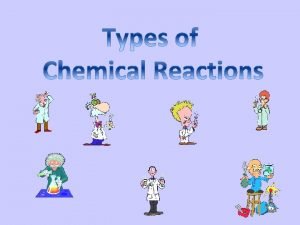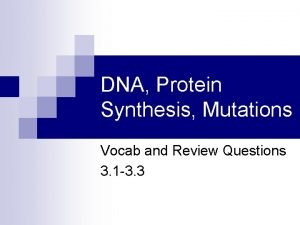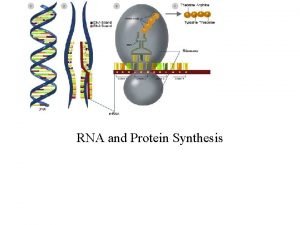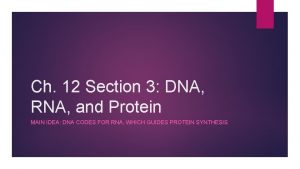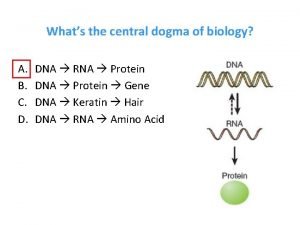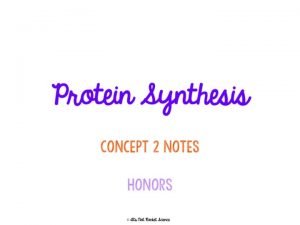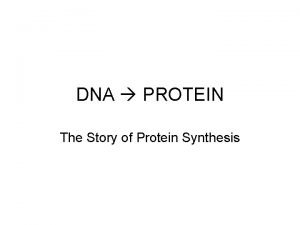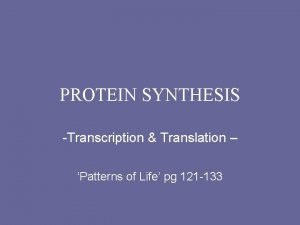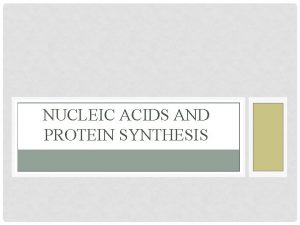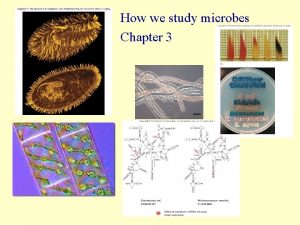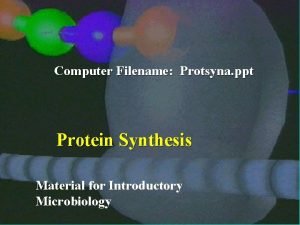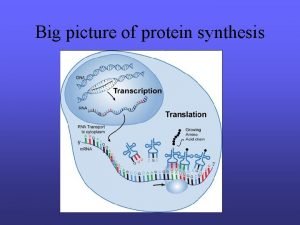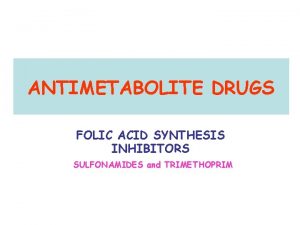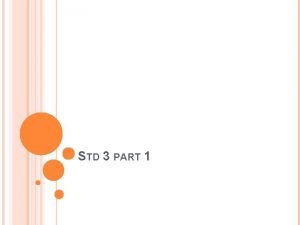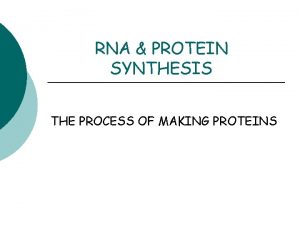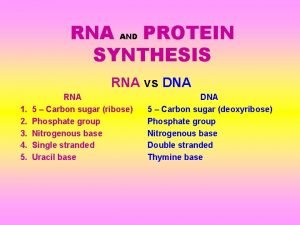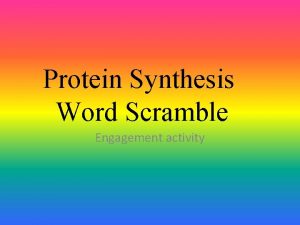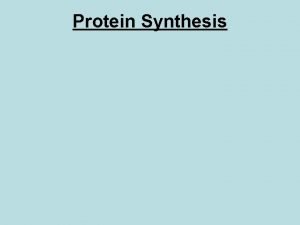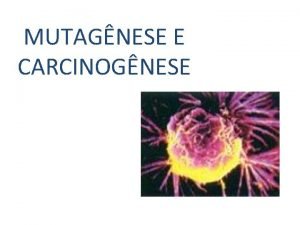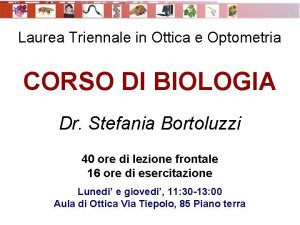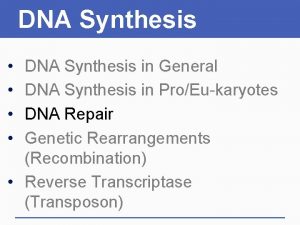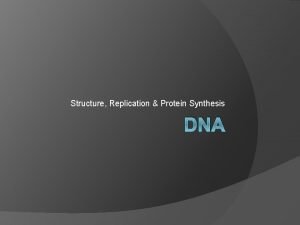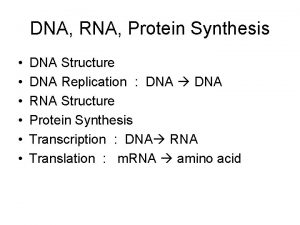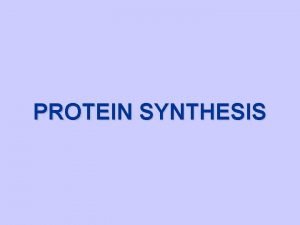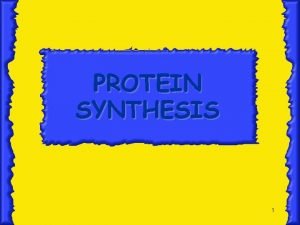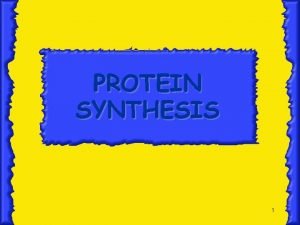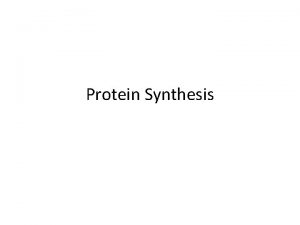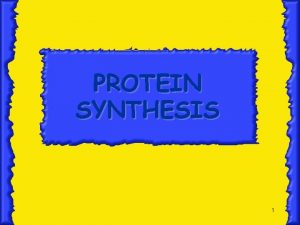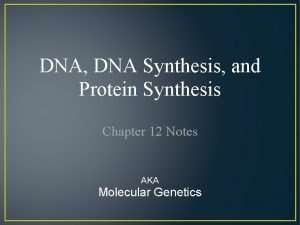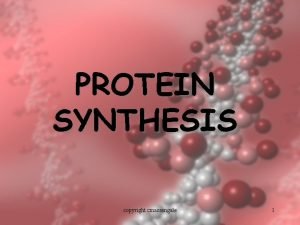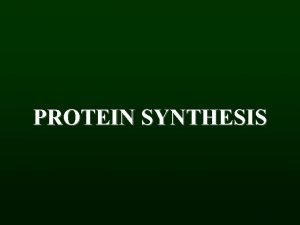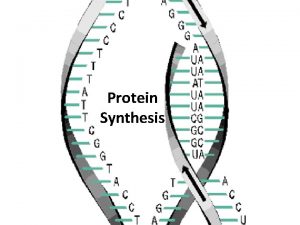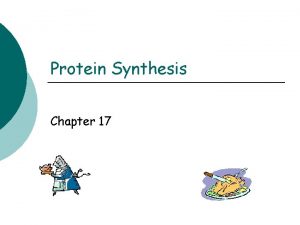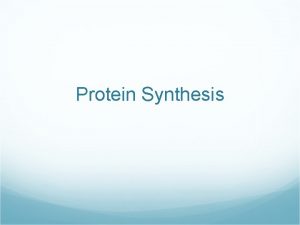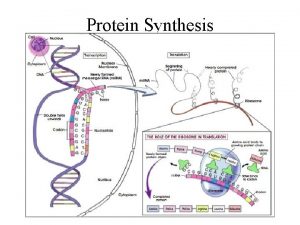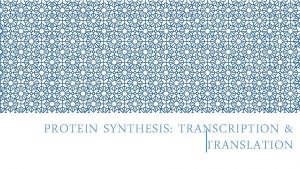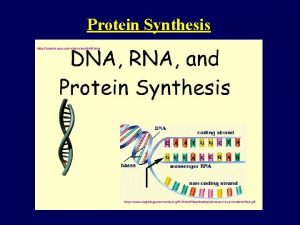DNA Structure and Protein Synthesis also known as



































- Slides: 35

DNA Structure and Protein Synthesis (also known as Gene Expression)

Protein Synthesis • • The process of making proteins… Boring stuff? Nope This is how the information in your genes is used to build… you!

DNA • Deoxyribonucleic Acid (DNA) is found in what part of the cell? Nucleus • How is the DNA organized? Chromosomes!

Each strand of DNA is a POLYMER!! • Individual nucleotides are the monomers! • Monomers (nucleotides) are linked to form a long polymer of single-stranded DNA • In our cells, 2 DNA polymers are bonded together to form a LONG doublestranded polymer

The Parts of a Nucleotide • SUGAR – deoxyribose • Phosphate group (PO 4) • Nitrogen-containing base

A nucleotide

What are the 4 BASES? ADENINE THYMINE CYTOSINE GUANINE

A DNA POLYMER!! • Strong bonds hold the nucleotides together to form a ‘backbone’. • They occur between the sugar of one nucleotide and the phosphate of the next nucleotide.

MORE ABOUT THE BASES… • Adenine always bonds to thymine • Cytosine always bonds to guanine

• Adenine – Thymine (A-T) • Cytosine. Guanine (C-G)

How does DNA Replicate? • DNA replication is making a COPY of ALL the genetic information (ALL the bases of DNA). • This has to happen BEFORE cell division (either Mitosis or Meiosis) can occur. • WHY does it have to happen?

The role of DNA • The material that genes are made of… • Gene - segment of DNA that carries the information necessary to build a protein. • Information is encoded in the sequence (order) of the four DNA bases (ATGC). • A gene is a sequence of thousands of these bases that codes for a protein!


• The DNA in a single human cell = 3, 000, 000 bases (3 Billion!) • However, scientists were surprised that there are only about 30, 000 genes!!


DNA is Double Stranded Molecule • The four bases that make up the genetic code (ATGC) form complimentary pairs. • A pairs with T… G pairs with C. • If one strand is ACGCAATTGCATT • The other is TGCGTTAACGTAA • This makes it possible for DNA copy it’s self…

Make a complementary strand! • TTCCGATCGGCGTATCTGAGCGATCAG…. AAGGCTAGCCGCATAGACTCGCTAGTC

What is a gene? • A Segment of DNA that contains the information that codes for a protein!!!


How do genes result in proteins? • The DNA is in the NUCLEUS of the cell. • Proteins are made on the ribosomeswhere? • In the cytoplasm! • So, the information needs to leave the nucleus…. . • Can the DNA can leave the nucleus?

• NO, it cannot! • The information for the gene needs to be copied in a way that the information CAN leave the nucleus! • This process is the 1 st step in Protein Synthesis- TRANSCRIPTION

Transcription: • The information in the DNA is copied into a molecule of RNA (Ribonucleic acid). • DNA can’t leave the nucleus so …a messenger (copy) is sent. • m. RNA is the messenger.

How is RNA different from DNA? • Monomer is a nucleotide with Ribose sugar, nitrogen base, and phosphate group • In RNA, nitrogen bases are: Adenine, Guanine, Cytosine, and URACIL • Complementary base pairs are C-G; A-U)

• RNA is Single Stranded; DNA is double stranded • DNA: ATGCGTTAC • m. RNA: UACGCAAUG

• http: //www. dnalc. org/resources/3 d/03 mechanism-of-replication-basic. html

Transcribe this DNA sequence! • DNA: GCCTTAAGACATTGTATGCCTAG • Complementary m. RNA: CGGAAUUCUGUAACAUACGGAUC

What are differences between m. RNA & DNA • • Location? Nucleotides? Double stranded? Single Stranded? How much genetic information is contained?


TRANSLATION • What do you do when you go from one language to another? You TRANSLATE! • m. RNA carries the instructions for building the protein • It takes place on the ribosomes (cellular machine that makes the protein by joining amino acids)

Translation • The Sequence (order) of bases in the DNA/RNA determines the order of amino acids in the protein! • The information is translated from the language of DNA/RNA (nucleic acids) to the language of proteins (amino acids).

What does the cell need to translate a m. RNA? • m. RNA- information for making the protein • t. RNA- type of RNA that actually translates the information from nucleic acid (RNA) to amino acid (protein) • Ribosome- the “machine” where translation takes place; binds the m. RNA, t. RNA, and joins the corresponding amino acids (the monomers of proteins!)

How is the m. RNA translated to make a protein? • Correct t. RNA with an amino acid attached “reads” 3 nucleotides (a codon) in the m. RNA and puts the correct amino acid in the growing polypeptide (unfolded protein!). • This happens in the ribosome!!


Summary of transcription and translation • Transcription – A copy of the information in DNA for a gene is encoded into RNA (takes place in nucleus). • Translation – The RNA (messenger) serves as the plan for building a protein using t. RNA as the translator and the ribosome as the “machine” (takes place in cytoplasm)

• http: //www. lewport. com/10712041113402793/lib/107120 41113402793/Animations/Protein%20 Synt hesis%20%20 long. swf
 Dna and genes chapter 11
Dna and genes chapter 11 Dna rna and protein synthesis study guide
Dna rna and protein synthesis study guide Double replacement cartoon examples
Double replacement cartoon examples Section 12 3 rna and protein synthesis
Section 12 3 rna and protein synthesis 4 steps of protein synthesis
4 steps of protein synthesis Protein synthesis and mutations
Protein synthesis and mutations Protein synthesis and mutations
Protein synthesis and mutations Rna transfer
Rna transfer Chapter 12 section 3 dna rna and protein
Chapter 12 section 3 dna rna and protein Totipotent cell
Totipotent cell Messenger rna codons
Messenger rna codons Cell restaurant analogy
Cell restaurant analogy Translation or transcription
Translation or transcription Transcription and translation bbc bitesize
Transcription and translation bbc bitesize Cookie monster analogy
Cookie monster analogy Elongation
Elongation Protein synthesis
Protein synthesis Protein synthesis
Protein synthesis Protein synthesis
Protein synthesis Synthesis
Synthesis Protein synthesis animation mcgraw hill
Protein synthesis animation mcgraw hill Parent genotype
Parent genotype Translation protein synthesis
Translation protein synthesis Protein synthesis
Protein synthesis Protein synthesis
Protein synthesis Protein synthesis ppt
Protein synthesis ppt Picture transcription
Picture transcription Paba
Paba Which best summarizes the process of protein synthesis?
Which best summarizes the process of protein synthesis? Concept map of protein synthesis
Concept map of protein synthesis Protein synthesis
Protein synthesis Protein synthesis scramble
Protein synthesis scramble Steps of protein synthesis
Steps of protein synthesis Dna nucleotide
Dna nucleotide Protein synthesis
Protein synthesis Sintese de proteinas na celula
Sintese de proteinas na celula


